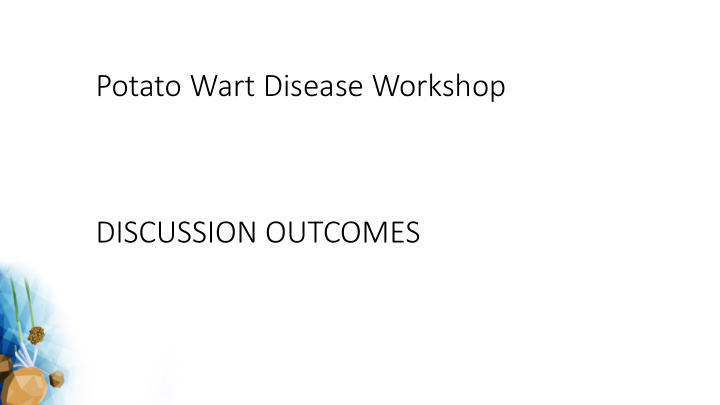



Potato Wart Disease Workshop DISCUSSION OUTCOMES
Disease occurrence and management The general view is that problems with potato wart are increasing. Even though in some countries where the pathogen is present the situation seems to be under control, new outbreaks are reported in (e.g.) Greece, Georgia, Denmark, Sweden and Bulgaria. Also when outbreaks are found these are generally from higher pathotypes. New pathotypes have been reported, one of which produces small wart formation on varieties with pathotype 18(T1) resistance. Not all findings are reported, likely due to the severe measures that are enforced after a finding. Governments could maybe lower the reporting threshold by offering more support and maybe even financial compensation. Also, many countries do not monitor for potato wart, or monitor too little. The differences of land use (big companies versus small home producers) makes it difficult to have a single control and management strategy. The use of partial resistance in management was regarded as unsuitable as they can present a genetic bottleneck for the pathogen populations and select for more virulent individuals from the population. It was noted that this could maybe also be the case for potato varieties that offer qualitative resistance. The use of partial resistant varieties could have its use only in non-infected areas. Short crop rotation should be avoided because it potentially increases the occurrence of outbreaks. The question was raised if alternative hosts could explain the discrepancy between resting spore survival in the lab and in the field. Unfortunately, there is a knowledge-gap about alternative hosts that could act as reservoirs. The role of climate change (higher temperatures and heavier rainfall), and distribution of spores with (flooded) rivers were discussed but are currently unsure. For the release of contaminated soils a molecular assay for spore viability is needed.
Pathogen biology Technical harmonization of the bioassays presented in the EPPO standard for pathotype identification were regarded sufficient, although the potato differential set was regarded too small by several groups which could lead an underestimation of the number of pathotypes and hence virulence towards resistant varieties. Comparison between the different (forms of) the different pathotyping bioassays is needed. It was noted that a small standardized potato variety set is needed for comparison of results in different countries, but that extended sets might be needed for local situations. Availability of the EPPO differential set was discussed. The potato varieties are not available to all countries pathotyping S. endobioticum isolates. A central potato gene bank that provides tubers to labs performing the bioassays would be highly valuable. The mycological EURL or SASA could play a role in this, but also maybe other institutes. It was acknowledged that fungal isolates are genetic populations and that even though they have the same phenotype they can have different underlying genotypes (e.g. the European and Canadian pathotype 6(O1) isolates). This would justify a source of standardized pathogen inoculum. However, it was generally considered to be very difficult to realize. Rather we could have best practice procedures to maintain isolates in culture to prevent drift in the genetic population. Such best practices would include standard varieties for pathogen maintenance. It was also noted that inoculum should be regularly analyzed molecularly to check the stability of the isolate. There is great interest in molecular methods for pathotyping. Ideally these are based on functional markers such as the AvrSen1 gene, but molecular tests based on association are more within reach. However, due to the diversity of the fungal genetic population, these diagnostic relevance of these associated markers could be (too) low.
Host resistance/Breeding Varieties with multiple resistances exist but these do not always possess the required agronomical traits. For instance, there are relatively few potato varieties for the consumption market that have resistance to higher pathotypes. There is a need for molecular markers that allow marker assisted breeding for potato wart resistance. Haplotype specific markers and pedigree analysis will allow to establish redundancy among current resistance sources. Also such analysis will allow to improve the current differential set. It was noted that sometimes public databases contain potato varieties that are mischaracterized, and that diploid breeding material was not sufficiently characterized. Also, crossable wild Solanum species could be assessed in search of new potato wart resistance. Bottlenecks of current phenotyping methods were: testing capacities, availability of sufficient plant material and inoculum. A continued effort in the research on identifying R genes and corresponding Avr genes was regarded of importance as alterative phenotyping assays. Stacking of R genes was regarded to be essential for breeding durable resistance against higher (more complex) pathotypes. It was noted that stacking of multiple narrow spectrum resistance genes is not desired. There is a need for a few broad spectrum resistance genes. Finally, resistance breeding alone can't solve the problem, and an integrated approach is needed. Governments could play a role in further bridging the gap between breeding and Q-regulation.
Any other related topic A need for a S. endobioticum collection was expressed that could hold and maintain reference materials. Perhaps there should be a main facility and another backup facility. It was suggested that the NVWA could play a role in this. It was noted that certain groups cannot keep strains in their own labs. Also, the need for a network of laboratories with expertise in S. endobioticum was expressed. Furthermore, increasing the frequency of workshops like this one should be considered, for instance every 2 or 3 years rather than every 10 years. Maybe these potato wart meetings could be linked to other meetings such as EAPR or the EPPO plant pest meetings.
Recommend
More recommend